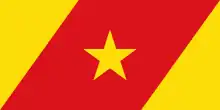Efratana Gidim
Efratana Gidim (Amharic: ኤፍራታ ግድም Efrata and Gedem") is one of the woredas in the Amhara Region of Ethiopia. It is named after two historic districts that were part of the former autonomous kingdom of Shewa, Efrata and Gedem. Part of the Semien Shewa Zone, Efratana Gidim is bordered on the south by Kewet, on the southwest by Menz Mam Midir, on the west by Menz Gera Midir, on the north by Antsokiyana Gemza, and on the east by the Oromia Zone. The administrative center of this woreda is Ataye (Effeson); other towns in Efratana Gidim include Jewha and Karakore.
Efratana Gidim
ኤፍራታ ግድም | |
|---|---|
 Flag | |
| Zone | Semien Shewa |
| Region | Amhara Region |
| Area | |
| • Total | 516.85 km2 (199.56 sq mi) |
| Population (2012 est.) | |
| • Total | 121,308 |
Overview
The highest point in the woreda, as well as the Semien Shewa Zone, is Mount Abuye Meda (4012 meters).
Demographics
Based on the 2007 national census conducted by the Central Statistical Agency of Ethiopia (CSA), this woreda has a total population of 110,493, an increase of 9.94% over the 1994 census, of whom 55,672 are men and 54,821 women; 15,319 or 13.86% are urban inhabitants. With an area of 516.85 square kilometers, Efratana Gidim has a population density of 213.78, which is greater than the Zone average of 115.3 persons per square kilometer. A total of 26,239 households were counted in this woreda, resulting in an average of 4.21 persons to a household, and 25,427 housing units. The majority of the inhabitants practiced Ethiopian Orthodox Christianity, with 88.46% reporting that as their religion, while 10.99% of the population said they were Muslim.[2]
The 1994 national census reported a total population for this woreda of 100,507 in 17,323 households, of whom 50,422 were men and 50,085 were women; 16,515 or 16.43% of its population were urban dwellers. The three largest ethnic groups reported in Efratana Gidim were the Amhara (95.27%), the Argobba (2.9%), and the Oromo (1.11%); all other ethnic groups made up 0.72% of the population. Amharic was spoken as a first language by 98.59%, and Oromiffa was spoken by 0.98%; the remaining 0.43% spoke all other primary languages reported. The majority of the inhabitants practiced Ethiopian Orthodox Christianity, with 88.74% reporting that as their religion, while 10.99% were Muslim.[3]
Notes
- Geohive: Ethiopia Archived 2012-08-05 at the Wayback Machine
- Census 2007 Tables: Amhara Region Archived November 14, 2010, at the Wayback Machine, Tables 2.1, 2.4, 2.5, 3.1, 3.2 and 3.4.
- 1994 Population and Housing Census of Ethiopia: Results for Amhara Region, Vol. 1, part 1 Archived November 15, 2010, at the Wayback Machine, Tables 2.1, 2.7, 2.10, 2.13, 2.17, Annex II.2 (accessed 9 April 2009)